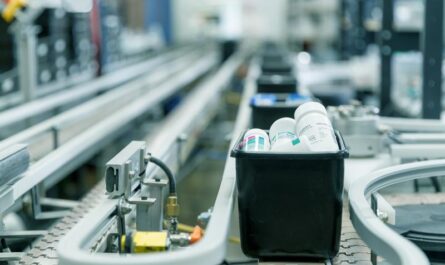
The lateral flow assay is an analytical technique used for testing biological samples like blood or urine. Often referred to as an immunochromatographic strip test, it is a simple to use platform for point-of-care testing.
How does a Lateral Flow Assay Work?
A lateral flow assay works on the basic principle of chromatographic separation. The main components of an assay strip are sample pad, conjugate pad, nitrocellulose membrane and wicking pad. The sample pad is where the test sample is applied. It contains the test conjugate, usually colloidal gold or colored latex particles coated with an antibody specific to the target analyte.
As the sample moves through the strip via capillary action, it hydrates the conjugated pad and dissolves the conjugate. The conjugate-analyte complex then migrates along with the fluid flow. The nitrocellulose membrane contains a test zone and control zone. The test zone is pre-coated with capture antibodies specific to the target analyte. If the target analyte is present in the sample, it will bind to the conjugated antibody particles to form complexes. These complexes are then captured by the immobilized antibodies in the test zone, resulting in the appearance of a visible colored test line.
The control line contains capture antibodies that bind to the conjugated particles regardless of the presence/absence of target analyte. This control line validates proper functioning of the test. The wicking pad absorbs and transports excess fluid to complete the assay process within 10-30 minutes, depending on the target analyte. A visible test line along with control line indicates a positive result, while only the control line signifies a negative result.
Applications of Lateral Flow Assay
Due to its ease of use and rapid results, lateral flow assays have wide applications in healthcare diagnostics and other fields:
Pregnancy Testing
The detection of human chorionic gonadotropin (hCG) is one of the earliest and most common applications of lateral flow assays. Brands like Clearblue and First Response use dedicated test strips coated with anti-hCG antibodies to detect pregnancy within the first week.
Infectious Disease Testing
Strips are available for detecting antigens or antibodies of various infectious agents like influenza A & B, respiratory syncytial virus (RSV), hepatitis B, HIV, malaria etc. These POC tests provide quick diagnosis without the need for specialized equipment or laboratory infrastructure.
Drugs of Abuse Testing
Semi-quantitative immunoassay strips detect drug metabolites in urine samples to check for illicit/prohibited substance use. Commonly screened drugs include amphetamines, benzodiazepines, cocaine, opioids, marijuana and barbiturates.
Fertility Testing
Ovulation prediction kits use LH (luteinizing hormone) detection strips to determine the most fertile days of a woman’s menstrual cycle for planning conception.
Food Safety and Environment Testing
Assays are employed for veterinary and agricultural applications like detection of pathogens, hormones, GMOs, toxins and contaminants in food/feed/water samples.
Benefits and Drawbacks of Lateral Flow Assay
Benefits:
– Simple one-step procedure with no specialized skills required.
– Rapid results within minutes.
– Minimal sample preparation required.
– High sensitivity and selectivity with incorporation of advanced materials.
– Shelf stable, disposable tests are portable and suitable for decentralized/POC testing.
Drawbacks:
– Semi-quantitative or qualitative results only, specific readings not possible.
– Unable to multiplex detection of multiple targets in single sample.
– Storage and transport conditions critical to ensure stability.
– Relatively higher cost per test than standardized lab-based techniques.
– Varied performance with different sample types.
Applications in COVID-19 Testing
With the COVID-19 pandemic, lateral flow assays have become frontline diagnostic tools worldwide. Some salient uses are:
Rapid Antigen Tests
These test strips detect SARS-CoV-2 nucleocapsid viral antigens from nasal/throat swabs. Brand leaders include Abbott PanBio, SD Biosensor Standard Q, Roche SARS-CoV-2 and BioneXXnow COVID-19 Agtesting. Positive results indicate active infection within a week of exposure.
Home/Self-Use Testing
FDA approved self-tests from BD Veritor and Quidel Sofia allow for convenient home screening without lab visits. Involvement of less trained individuals requires simple, intuitive tests.
Asymptomatic Screening
Mass screening programs depend majorly on antigen LFAs for their affordability and ease of mass deployment. Large scale testing aided countries like UK and India to identify hotspots early.
Surveillance and Epidemic Control
Serial antigen testing is a strategic approach adopted by several organizations, schools and workplaces to monitor outbreaks and curb community transmission through periodic screening.
Onsite Testing Labs
Portable lateral flow based analyzers from manufacturers like Abbott, LumiraDx and SD Biosensor enabled setting up temporary testing facilities anywhere. This facilitated rural/interior region access to diagnostics.
Conclusion
In summary, the lateral flow assay platform has revolutionized point-of-care testing due to its user-friendly features. It has undoubtedly played a pivotal role in managing the COVID-19 health crisis by enabling widespread diagnostics. With continued refinements using cutting-edge materials, LFAs promise wider healthcare applications to diagnose and prevent diseases globally.
*Note:
1. Source: Coherent Market Insights, Public sources, Desk research
2. We have leveraged AI tools to mine information and compile it



